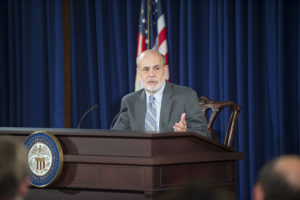
Chairman Ben S. Bernanke addresses members of the media during the question-and-answer portion of the press conference held on September 18, 2013. The event followed the September 17-18 meeting of the Federal Open Market Committee (FOMC).
You read here on Youngresearch.com for years about the problems with quantitative easing, but despite our pleas, the Federal Reserve and other central banks persisted. Now, Allison Schrager, a senior fellow at the Manhattan Institute, joins the chorus of those speaking out against quantitative easing and hoping that it will be retired from the Fed’s monetary policy arsenal forever. She writes at Bloomberg:
The great quantitative easing experiment was a mistake. It’s time central banks acknowledge it for the failure it was and retire it from their policy arsenal as soon as they’re able.
Since the global financial crisis of 2008, an integral part of central banks’ play book in the US, the UK and the European Union has been QE — the practice of buying up long-term bonds and mortgage-backed securities. QE is supposed to work by lowering long-term interest rates, which boosts demand and increases lending and risk-taking.
